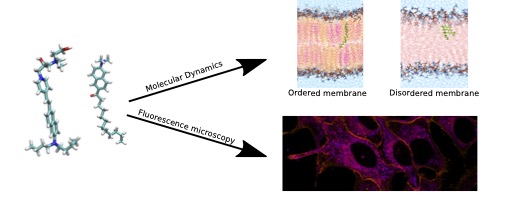In our latest manuscript, we elucidate the atomistic mechanisms that define the interactions between two commonly used environmentally sensitive dyes (Laurdan & di-4-ANEPPDHQ) and liquid-ordered (Lo) and liquid-disordered (Ld) lipid bilayers which they are used to investigate. Laurdan and di-4-ANEPPDHQ are solvatochromatic dyes that are perfect for probing lipid phases as the more loosely packed Ld phase presents are significantly more hydrated than the more tightly packed Lo phase, which results in a significant fluorescence spectrum shift of the dyes. However, the underlying knowledge of the exact mechanisms behind these spectral shifts is still lacking and understudied. Furthermore, the effect that these dyes have on the intrinsic properties of the membranes they are probing is unknown. In this work, we combine a multi-scale computational investigation of these dye molecules and their interactions with Lo and Ld membranes with complimentary fluorescence imaging of giant unilamellar vesicles and live HeLa cells to demonstrate how the lipid order reported by these dyes depends on their staining concentration and the molecular mechanisms which drive this dependence. In doing so, our results show the profound effect that environmentally sensitive (ES) dyes have on the lipid membranes they probe.
The importance of this work is that it:
- Provides a detailed description of the effect of these ES dyes on the lipid membranes they probe. We show that the presence of both dyes has an effect on the level of hydration of the headgroups of proximal lipid molecules. Additionally, we show that the presence of the dyes result in a reduction in the order of the proximal lipid molecules in both cases. In fact, we show that in the case of di-4-ANEPPDHQ the reduction in order of the lipids is at least in part due to the fact that the dye molecules maintain a level of hydration as they enter the bilayer.
- Reports a significant concentration dependence on the GP values found with di-4-ANEPPDHQ in HeLa cells. We found that the measured GP value of low concentrations of di-4-ANEPPDHQ in the ‘disordered’ regions of the cell membrane is practically indistinguishable from the measured GP value of higher concentrations of the dye in the ‘ordered’ regions of the cell membrane. Meanwhile, we observe no such change in the measured GP for Laurdan across the same concentration range in the HeLa cell membranes. This indicates that (1) di-4-ANEPPDHQ may preferentially partition into the liquid ordered phase of cell membranes and (2) that Laurdan may be more suitable for biological experiments where a comparison between samples is required and the exact dye:lipid ratio cannot be easily quantified.
- Reports the first model of the ground and excited states of di-4-ANEPPDHQ. Using density functional theory and linear-response time-dependent density functional theory, we have determined an accurate representation of the charge distribution within the di-4-ANEPPDHQ molecule in its ground and excited states. Previously, similar studies had been done for PRODAN and Laurdan, although never have the values been published for others to use for Laurdan, but this is the first time it has been reported for di-4-ANEPPDHQ.
 Full reference: Laurdan and Di-4-ANEPPDHQ Influence the Properties of Lipid Membranes: A Classical Molecular Dynamics and Fluorescence Study. Adam Suhaj, Duncan Gowland, Nicola Bonini, Dylan M. Owen & Christian D. Lorenz, Journal of Physical Chemistry B (2020) 124 (50), 11419-11430.
Full reference: Laurdan and Di-4-ANEPPDHQ Influence the Properties of Lipid Membranes: A Classical Molecular Dynamics and Fluorescence Study. Adam Suhaj, Duncan Gowland, Nicola Bonini, Dylan M. Owen & Christian D. Lorenz, Journal of Physical Chemistry B (2020) 124 (50), 11419-11430.
